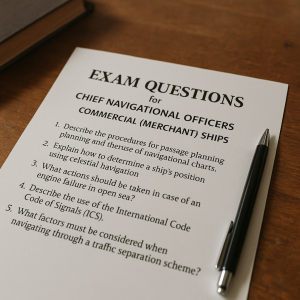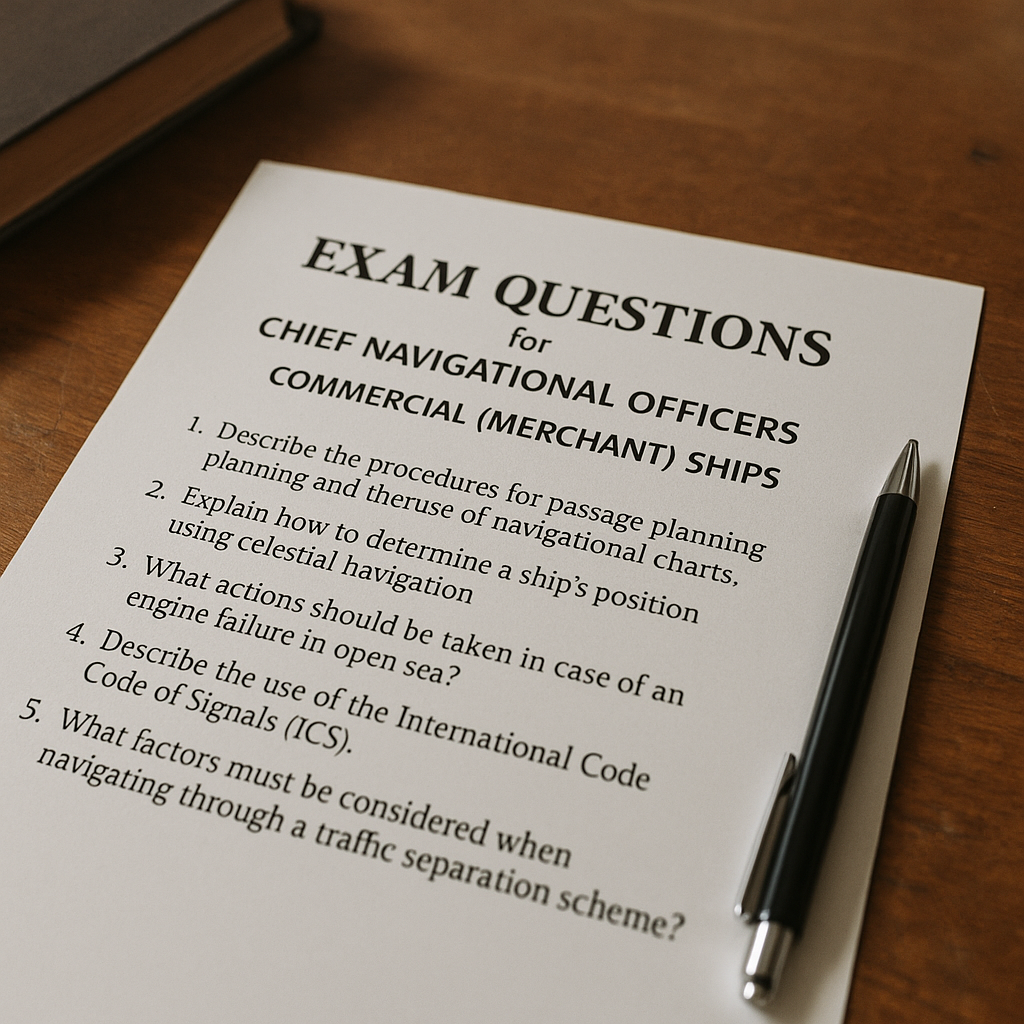Prepare for your chief navigational officer exams with confidence. This detailed guide presents the top 40 exam questions, real-world scenarios, and expert tips tailored for senior officers on merchant ships.

A chief navigational officer, commonly referred to as the Chief Officer or Chief Mate, is more than just second-in-command — they are the operational core of a merchant vessel. As ships become smarter, regulations tighter, and voyages riskier, the competency and confidence of a Chief Officer can determine everything from commercial efficiency to crew survival.
This guide provides a comprehensive breakdown of the top 40 exam questions typically asked in oral and written assessments for chief navigational officers. Whether you’re sitting for the UK MCA oral, Australian AMSA, India’s DG Shipping, Transport Canada, or any STCW-compliant authority, this article helps you approach your exams with clarity and relevance.
Why Chief Officer Exams Matter in Modern Maritime Operations
Chief Officers play a critical role under STCW Regulation II/2, with duties spanning cargo operations, stability, navigation, safety, pollution prevention, and leadership. According to the International Chamber of Shipping (ICS) and BIMCO, the global demand for experienced senior officers is rising, with an estimated shortage of over 20,000 officers worldwide as of 2021 (BIMCO/ICS Seafarer Workforce Report).
In an era of environmental scrutiny, cyber-security threats, ECDIS navigation, and ballast water compliance, Chief Officers are expected to balance shipboard management with strategic maritime knowledge. Exams, therefore, go beyond procedural memory — they test judgment, leadership, and foresight.
Key Categories of Chief Officer Exam Questions
The following sections group questions into primary STCW competency areas, supported by real-world applications and current maritime regulations.
Ship Stability and Cargo Operations
- Explain the effect of suspended weights on vessel stability.
- Suspended loads shift the center of gravity upward, reducing GM, which increases the risk of capsizing in rough seas.
- How do you manage stability when loading heavy lifts?
- Calculate heeling moments, use ballast, maintain sufficient GM using the stability booklet and onboard loading software.
- What is the purpose of the Cargo Securing Manual (CSM)?
- Mandated under SOLAS Chapter VI, it ensures proper stowage/lashing to prevent cargo shift.
- Describe the precautions for loading liquefied gas cargo.
- Reference IGC Code: Inerting tanks, monitoring temperature/pressure, avoiding thermal shock.
- Explain the difference between GM and GZ.
- GM is a static measure of stability (initial), GZ is dynamic and indicates the righting arm over the range of heel.
Passage Planning and Bridge Resource Management
- What are the four stages of passage planning as per IMO?
- Appraisal, Planning, Execution, Monitoring. Ref: IMO Resolution A.893(21).
- How do you manage fatigue during long navigational watches?
- Use bridge team rotation, maintain minimum hours of rest (STCW Section A-VIII/1), practice effective BRM.
- What should be included in a berth-to-berth passage plan?
- No-go areas, wheel over points, UKC, tidal windows, contingency routes.
- Explain the use of Under Keel Clearance (UKC) management tools.
- Dynamic UKC software (like DUKC by OMC), echo sounders, tide tables.
- What is the importance of the Parallel Indexing technique?
- Enables safe monitoring of vessel’s position relative to dangers, especially in pilotage waters.
Maritime Regulations and Documentation
- List the mandatory ship certificates under SOLAS.
- SMC, DOC, Load Line, IOPP, Safety Construction, Radio Certificate, ISPS.
- What actions follow the expiry of a Class Certificate?
- Inform Class Society, cease trading if required, arrange survey and reinstatement.
- Explain the role of the Safety Management System (SMS).
- Ensures compliance with the ISM Code for safe operation and environmental protection.
- What are the key MARPOL Annexes applicable to Chief Officers?
- Annex I (Oil), II (Noxious Liquid Substances), III (Harmful Substances), V (Garbage), VI (Air Emissions).
- How often is a Cargo Securing Manual reviewed or amended?
- Typically every five years or as per vessel modification/cargo changes, approved by Flag/RO.
Leadership, Safety, and Emergency Preparedness
- Describe the Chief Officer’s role during abandon ship.
- Muster supervisor, checks crew, ensures lifesaving appliances are ready, informs Master.
- How do you manage multicultural crew conflicts?
- Use IMO Model Course 1.39 (Leadership), promote mutual respect, hold inclusive safety meetings.
- What is the importance of risk assessment before starting cargo operations?
- Identifies hazards, implements controls (Hierarchy of Control), mandatory per ISM.
- What steps are taken during a fire in the cargo hold?
- Raise general alarm, close hatches, activate CO₂ system, isolate ventilation.
- How do you conduct enclosed space entry procedures?
- Permit-to-work, check atmosphere (O₂ >19.5%, LEL <10%), rescue gear standby.
Ballast Water and Environmental Compliance
- Explain ballast water exchange requirements under the BWM Convention.
- Conduct 200 nm from shore at >200 m depth or treat onboard; log in Ballast Record Book.
- What is the role of the Oil Discharge Monitoring Equipment (ODME)?
- Measures and controls oil discharge within MARPOL Annex I limits (<15 ppm).
- How do you handle a MARPOL violation observation by a port authority?
- Cooperate fully, inform company, document findings, consult P&I Club or legal adviser.
- How is garbage segregated and disposed of onboard?
- Per MARPOL Annex V: Food waste, plastics, dunnage, oil rags stored separately and logged.
- What are the key aspects of a Ship Energy Efficiency Management Plan (SEEMP)?
- Measures to reduce GHG, fuel tracking, EEXI compliance (per IMO 2023 Strategy).
ECDIS and Navigation Technologies
- Describe the differences between vector and raster charts.
- Vector: interactive ENC, layered; Raster: scanned images, less flexible.
- How do you respond to a GPS spoofing event?
- Verify with radar, visual bearings, cross-check with AIS, inform Master and report to authorities.
- What are safety settings on ECDIS?
- Safety contour, safety depth, shallow contour, alert zones — per S-52 presentation library.
- What are the training requirements for using ECDIS?
- Generic and type-specific training per IMO Model Course 1.27 and STCW A-II/2.
- How is passage plan approved and monitored in ECDIS?
- Validated against ENC errors, crosschecked with pilot charts, signed by Master.
Cargo Documentation and Charter Party Terms
- What is the difference between a Bill of Lading and Mate’s Receipt?
- BoL: Legal transport document; MR: draft issued before BoL confirmation.
- Explain NOR and its legal implications.
- Notice of Readiness starts laytime under charter party terms; must be validly tendered.
- Describe the use of the IMDG Code.
- Classifies dangerous goods, details packing, segregation, and emergency response.
- What is a Cargo Manifest and why is it important?
- Lists all cargo onboard with weight, value, consignee; needed for customs and safety.
- What is the Chief Officer’s responsibility in case of cargo damage?
- Notify Master, document with photos, record in Cargo Log, inform insurer/charterer.
Vetting, PSC Inspections, and Class Surveys
- What is the PSC inspection checklist for deck department?
- Charts, passage plan, GMDSS, lifeboats, fire detection, ISPS, MARPOL gear.
- How do you handle an oil spill during bunkering?
- Stop operation, activate SOPEP, notify port/state, record in ORB.
- What is SIRE and why does it matter?
- Ship Inspection Report Programme by OCIMF; essential for tankers to get business.
- What is a Class Survey and when is it conducted?
- Confirms structural/mechanical integrity; annual, intermediate, renewal, or occasional surveys.
- What are deficiencies commonly noted by Paris MoU?
- Fire safety, navigation charts, ISM documentation, lifeboat drills (Paris MoU Annual Report).
Real-World Applications and Learning from Incidents
In 2020, a tanker failed a SIRE vetting due to incomplete cargo calculations and poor documentation — all linked to Chief Officer responsibilities. Similarly, a 2023 MAIB investigation revealed how a poorly managed ballast exchange led to critical list and near grounding.
These are not just case studies. They are lived examples of how exams reflect everyday scenarios.
FAQ: What Candidates Often Ask
How do I prepare efficiently for the Chief Mate oral exam?
Use past papers, mock orals, STCW tables, and practice decision-making through real-case scenarios.
Are these questions valid globally?
Yes — while style may vary, content is aligned with STCW II/2. Most flag states follow similar frameworks.
What are the best books for Chief Officer prep?
“Ship Stability for Masters and Mates” (Martin Rhodes), “Bridge Procedures Guide” (ICS), and IMO model courses.
Can ECDIS replace paper charts entirely?
Yes, under SOLAS V/19, if dual ECDIS systems are installed and certified.
What happens if I make a mistake during the oral exam?
Don’t panic. Clarify, recover gracefully, and show correct rationale. Examiners assess judgment, not perfection.
Conclusion
Passing the Chief Officer exam is more than earning a CoC — it’s about stepping confidently into maritime leadership. With knowledge of real scenarios, regulation-backed understanding, and respect for bridge resource management, you become not just certified but competent.
Take time to revise each category. Reflect on your sea time. Learn from the accidents of others. And most of all, prepare not just to pass, but to lead safely.
References
- STCW Code (https://www.imo.org/en/OurWork/HumanElement/Pages/STCW-Convention.aspx)
- SOLAS Convention (https://www.imo.org/en/About/Conventions/Pages/SOLAS.aspx)
- BIMCO/ICS Seafarer Report (https://www.ics-shipping.org/publication/seafarer-workforce-report-2021/)
- ISM Code (https://www.imo.org/en/OurWork/Safety/Pages/ISMCode.aspx)
- Paris MoU Annual Report (https://www.parismou.org)
- MAIB Reports (https://www.gov.uk/maib-reports)
- OCIMF SIRE Programme (https://www.ocimf.org/programmes/sire/)
- Inmarsat GMDSS (https://www.inmarsat.com/en/services/safety/gmdss.html)
- IMO Ballast Water Management (https://www.imo.org/en/OurWork/Environment/Pages/BallastWaterManagement.aspx)
- The Nautical Institute (https://www.nautinst.org)
- Marine Insight (https://www.marineinsight.com)
- IHS Markit (now part of S&P Global) reports on ship vetting
- ICS Bridge Procedures Guide (5th Edition)
- Lloyd’s Register & DNV maritime training materials
- ECDIS S-52/S-64 documentation (via IHO.org)
- The American Practical Navigator (Bowditch) by Nathaniel Bowditch
- Ship Stability for Masters and Mates by Martin Rhodes
- Bridge Resource Management Model Course 1.39 (IMO)
- World Maritime University (WMU) Journal of Maritime Affairs
- Clarksons Research, VesselFinder, Equasis (data portals)
- MarineTraffic Live Map (https://www.marinetraffic.com)

